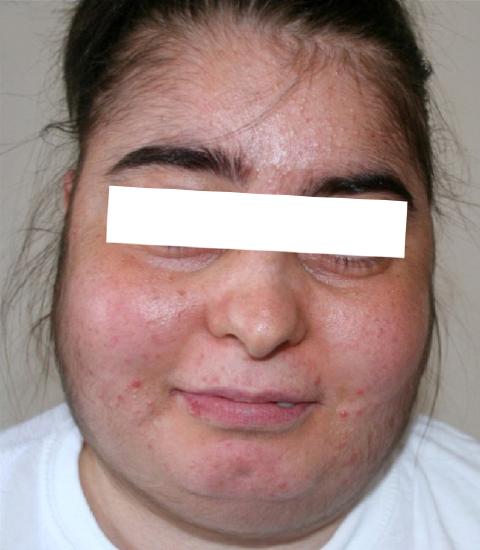12.2: Introduction to the Endocrine System
- Last updated
- Save as PDF
- Page ID
- 30703
Moon Face
The patient in Figure \(\PageIndex{1}\) has the characteristic moon face of a disorder named Cushing’s syndrome. Other signs and symptoms of this disorder include abnormal weight gain, acne, and excessive hairiness, among many other abnormalities. What can cause so many different problems in one patient? The answer is the overproduction of the endocrine system hormone cortisol.

Overview of the Endocrine System
The endocrine system is a system of glands called endocrine glands that release chemical messenger molecules called hormones into the bloodstream. Other glands of the body, including sweat glands and salivary glands, also secrete substances but not into the bloodstream. Instead, they secrete them through ducts that carry them to nearby body surfaces. These other glands are called exocrine glands.
Endocrine hormones must travel through the bloodstream to the cells they affect, and this takes time. Because endocrine hormones are released into the bloodstream, they travel throughout the body wherever blood flows. As a result, endocrine hormones may affect many cells and have body-wide effects. Endocrine hormones may cause effects that last for days, weeks, or even months.
Glands of the Endocrine System

The major glands of the endocrine system are shown in Figure \(\PageIndex{2}\). The glands in the figure are described briefly in the rest of this section. Refer to the figure as you read about the glands in the following text.
Pituitary Gland
The pituitary gland is located at the base of the brain. It is controlled by the nervous system via the brain structure called the hypothalamus, to which it is connected by a thin stalk. The pituitary gland consists of two lobes, called the anterior (front) lobe and posterior (back) lobe. The posterior lobe stores and secretes hormones synthesized by the hypothalamus. The anterior lobe synthesizes and secretes its own endocrine hormones, also under the influence of the hypothalamus. One endocrine hormone secreted by the pituitary gland is growth hormone, which stimulates cells throughout the body to synthesize proteins and divide. Most of the other endocrine hormones secreted by the pituitary gland control other endocrine glands. Generally, these hormones direct the other glands to secrete either more or less of their hormones. This is why the pituitary gland is often referred to as the “master gland” of the endocrine system.
Remaining Glands of the Endocrine System
Each of the other glands of the endocrine system is summarized below. Several of these endocrine glands are also discussed in greater detail in other concepts in the present chapter.
- The thyroid gland is a large gland in the neck. Thyroid hormones such as thyroxine increase the rate of metabolism in cells throughout the body. They control how quickly cells use energy and make proteins.
- The four parathyroid glands are located in the neck behind the thyroid gland. The parathyroid hormone helps keep the level of calcium in the blood within a narrow range. It stimulates bone cells to dissolve calcium and release it into the blood.
- The pineal gland is a tiny gland located near the center of the brain. It secretes the hormone melatonin, which controls the sleep-wake cycle and several other processes. The production of melatonin is stimulated by darkness and inhibited by light. Cells in the retina of the eye detect light and send signals to a structure in the brain named the suprachiasmatic nucleus (SCN). Nerve fibers carry the signals from the SCN to the pineal gland via the autonomic nervous system.
- The pancreas is located near the stomach. Its endocrine hormones include insulin and glucagon, which work together to control the level of glucose in the blood. The pancreas also secretes digestive enzymes into the small intestine.
- The two adrenal glands are located above the kidneys. Adrenal glands secrete several different endocrine hormones, including the hormone adrenaline, which is involved in the fight-or-flight response. Other endocrine hormones secreted by the adrenal glands have a variety of functions. For example, the hormone aldosterone helps to regulate the balance of minerals in the body. The hormone cortisol, which causes Cushing's syndrome when it is produced in excess, is also an adrenal gland hormone.
- The gonads include the ovaries in females and testes in males. They secrete sex hormones, such as testosterone (in males) and estrogen (in females). These hormones control sexual maturation during puberty and the production of gametes (sperm or egg cells) by the gonads after sexual maturation.
- The thymus gland is located in front of the heart. It is the site where immune system cells called T cells mature. T cells are critical to the adaptive immune system, in which the body adapts to specific pathogens.
Endocrine System Disorders
Diseases of the endocrine system are relatively common. An endocrine system disease usually involves the secretion of too much or not enough of a hormone. When too much hormone is secreted, the condition is called hypersecretion. When not enough hormone is secreted, the condition is called hyposecretion.
Hypersecretion

Hypersecretion by an endocrine gland is often caused by a tumor. For example, a tumor of the pituitary gland can cause hypersecretion of growth hormone. If this occurs in childhood and goes untreated, it results in very long arms and legs and abnormally tall stature by adulthood (see ). This condition is commonly known as gigantism. Martin Van Buren Bates is depicted in Figure \(\PageIndex{3}\) standing next to a man of average size. Bates was a Civil War-era American famed for his incredibly large size. He was at least 7 feet 9 inches tall and weighed close to 500 pounds. He was normal in size at birth but started to grow very rapidly by about age 6 years, presumably because of the hypersecretion of growth hormone.
Hyposecretion
Hyposecretion by an endocrine gland is often caused by the destruction of the hormone-secreting cells of the gland. As a result, not enough of the hormone is secreted. An example of this is type 1 diabetes, in which the body’s own immune system attacks and destroys cells of the pancreas that secrete insulin. This type of diabetes is generally treated with frequent injections of insulin.
Hormone Insensitivity
In some cases, an endocrine gland secretes a normal amount of hormone, but target cells do not respond normally to it. This may occur because target cells have become resistant to the hormone. An example of this type of endocrine disorder is Androgen Insensitivity Disorder. Individuals with this disorder are born with an X and Y chromosome but develop and raised as females. This is due to a mutation in the Androgen Receptor (AR) gene which is located on the X chromosome. Testosterone is an androgen hormone that causes testes to descend and typical male characteristics to develop. People with this form of the condition have the external sex characteristics of females but do not have a uterus and therefore do not menstruate and are unable to conceive a child (infertile). They are typically raised as females and have a female gender identity. Affected individuals have male internal sex organs (testes) that are undescended, which means they are located in the pelvis or abdomen.
Review
- What is the endocrine system? What is its general function?
- Compare and contrast endocrine and exocrine glands.
- How do endocrine system messages differ from those of the nervous system?
- Describe the role of the pituitary gland in the endocrine system.
- List three endocrine glands other than the pituitary gland, and identify their functions.
- Which endocrine gland has an important function in the immune system? What is that function?
- Define hypersecretion and hyposecretion.
- Name an endocrine disorder in which too much of a hormone is produced.
- What are two reasons people with diabetes might have signs and symptoms of inadequate insulin?
- Choose one. Cushing’s syndrome is an example of (hyposecretion/hypersecretion).
- True or False. The hypothalamus is the master gland of the endocrine system.
- True or False. Mammary glands that produce milk for offspring are part of the endocrine system.
- Melatonin is produced by the:
- A. Pituitary gland
- B. Hypothalamus
- C. Pineal gland
- D. Pancreas
- Besides location, what is the main difference between the anterior lobe of the pituitary and the posterior lobe of the pituitary?
- Which endocrine glands differ between males and females? Which hormones do they produce?
Explore More
Most people want to live a long, healthy life. Geneticist Cynthia Kenyon’s research suggests that endocrine hormones may be a key to human longevity. Watch this fascinating TED talk to learn how.
Emily Quinn is an artist and activist. In this video, she talks about the hardship that she experienced while growing up as an individual with Androgen Insensitivity Syndrome.
Attributions
- Cushing's face by Ozlem Celik, Mutlu Niyazoglu, Hikmet Soylu and Pinar Kadioglu CC BY 2.5 via Wikimedia Commons
- Endocrine glands by Mariana Ruiz Villarreal CC BY-NC 3.0 via CK-12 Foundation
- Martin Van Buren Bates by Magnus Manske; public domain via Wikimedia Commons
- Text adapted from Human Biology by CK-12 licensed CC BY-NC 3.0


